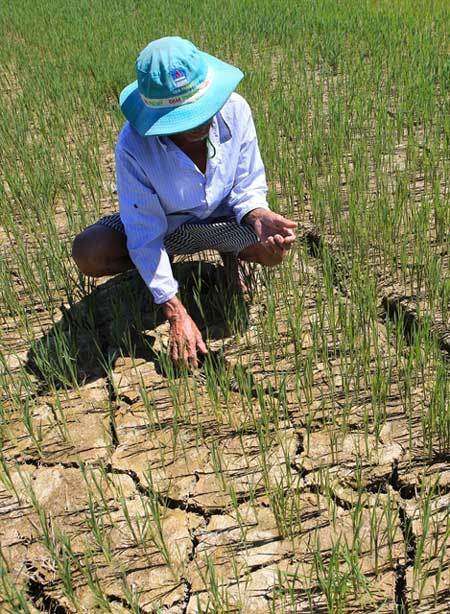Vietnam's central region faces serious drought
Heat wave hits three regions with temperature over 40C
 |
| A rice paddy in Thua Thien-Hue Province dried out and cracked by the prolonged heat wave. |
The local Nhan An Dong paddy field is drying up due to the prolonged heat wave.
Pointing out into his field, Diem said half of it was already destroyed by the extreme heat.
Bemoaning the loss of their crops, four local families pooled VND6 million (US$258) to dig a well with the hope of saving their dying fields.
“Many areas are parched… We must pay money to break the drought. Otherwise, the whole field will be burnt up,” he told Nông Thôn Ngày Nay (Countryside Today) newspaper.
Central provinces are experiencing unprecedented weather. Extreme, prolonged heat has pushed the livestock and crops of thousands of small households to the brink.
Local governments and people have been working hard to save their assets and water resources.
860ha of plants in Hoài Anh District, including 200ha of rice, have been destroyed because of the water shortage.
Paddy fields in the communes of An Hao Tay, An Tin, An Huu and An Duc have spotted countless cracks in the soil. Rice which was just planted is already dying.
According to Vo Duy Tin, deputy head of the district People’s Committee, all local reservoirs have run out of water, affecting not only agriculture but also residents' day-to-day lives.
Billions of dong have been allocated from the public budget to implement preventive measures against drought.
At present, 66 pump stations are being operated at full capacity to supply water for rice paddies.
“This year has witnessed the most tremendous drought in the last 15 years," Tin said. "Water resources from small rivers and streams have all dried up."
“We have to mitigate the impacts of droughts by setting up pumps in ponds to take more water,” he added.
According to the Binh Dinh Province Department of Agriculture and Rural Development, 140 out of 165 reservoirs in the province are running out of water. The rest are only operating at about 25 per cent of their capacities.
Meanwhile, prolonged heat has killed 481ha of rice in the province and affected some 11,400ha.
If the situation does not improve, more than 1,100ha of rice will die by the end of this month.
Farmers in the central province of Quang Nam are suffering the same ordeal, including those in the province's island localities.
Many paddy fields in districts of Dien Ban and Nui Thanh are abandoned due to the severe drought.
“Rice is blooming," said Duong Van Hieu, a farmer in Dien Ban District. "Without water, tens of hectares of paddy fields will not be able to survive. From now until the end of the season, water needs to be let into the fields three or four times, otherwise we may lose them all."
According to Truong Xuan Ty, head of Quang Nam Province Department of Water Resources, the province is working to protect 12,000ha of plants from drought and salt intrusion.
Despite their efforts, 100ha, mostly in Dien Ban Town and Duy Xuyen District, has already been ruined by the lack of water.
As a result of the environmental pressures, the agriultural sectors of Quang Tri and Thua Thien Hue provinces are predicting poor summer-autumn crops.
Most reservoirs in Quang Tri Province have reached record low water levels and are no longer able to supply water to rice paddies and fruit farms.
Meanwhile, nearly 2,000ha of rice in Thua Thien-Hue Province is threatened by the shortage. The provincial agriculture department has asked the Government to grant VND60.3 billion (US$2.5 million) to cover electricity and oil expenses for bump stations and maintenance on irrigation systems.
Drought map
Early this week, Minister of Agriculture and Rural Development Nguyen Xuan Cuong asked the Directorate of Water Resources to produce out a drought map for the central region in order to take stock of the problem, according to Vietnam News Agency.
Cuong also tasked the directorate with reviewing the demand for water in each locality to allow for proper adjustment of reservoirs during the dry season.
Households in these provinces will be supported by the National Centre for Rural Water Supply and Environmental Sanitation to build rain water tanks as a backup water supply.
The Department of Crop Production was told to recommend drought-tolerant crop varieties to replace existing rice plants and encourage farmers to begin raising cattle.
The directorate's director Nguyen Van Tinh said the drought in central region is likely to last until early August.
Some 65,500ha of crops will be impacted and nearly 138,800 households will have to deal with water shortage in their daily lives.
According to the World Meteorological Organisation, 2019 is predicted to be the hottest year in the last 140 years, further worsening the region's water scarcity.
VNS
 A scorching summer day in Hoai Nhon District, Binh Dinh Province could not stop farmer Tran An Diem from working hard to dig a well in search of a precious source of water.
A scorching summer day in Hoai Nhon District, Binh Dinh Province could not stop farmer Tran An Diem from working hard to dig a well in search of a precious source of water.